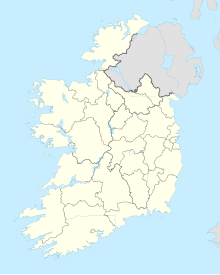Killavullen Caves
Coordinates: 52 ° 8 ′ 57 " N , 8 ° 30 ′ 55.2" W.
The Killavullen Caves ( Irish Pluaiseanna Chill at Mhuilinn ) are stalactite caves with three entrances near the village of Killavullen in County Cork , Ireland .
location
The main entrance, around 50 meters above sea level, is on the south bank of the Munster Blackwater River, around five meters above the current river bed level on the northern slope of the Nagle Mountains at the Killavullen Bridge.
description
The main cave has four chambers of different dimensions. They are connected by narrow corridors. The total length of the passages is around 200 meters. Killavullen Cave 2 and Killavullen Cave 3 are smaller caves, they only extend about five meters deep into the rock face.
The caves are particularly known for the large number of archaeological and paleontological remains. Excavations in the cave in 1934 revealed remains and bones of the extinct giant deer (Megaloceros giganteus), the fossilized specimens date from the Pleistocene to the early Holocene . It was one of the largest deer that ever lived. Further excavations brought to light a phrehistoric human skull. The cave decorations consist of stalactites such as stalactites , stalagmites and stalagnates with different diameters between 3 and 30 centimeters and a height between 1.0 and 1.2 meters.
stratigraphy
The basic stratigraphy of the cave system consists of a drip unit in contact with the subsoil on the floor through superimposed sediments, which then cover a dripstone unit with further sediments and an upper layer of sinter . The total depth of sediments is around 1 to 1.2 meters. The radiocarbon dating of the sediments after the AMS dating at> 47000 BP resulted in 9710 ± 60 BP for the lowest unit and 9030 ± 60 BP according to the Libby method for the middle unit.
Web links
- Age dating of speleothems in Killavullen Caves, County Cork, Ireland University College Cork, Dept. of Geology, Western Road, Cork, Ireland


